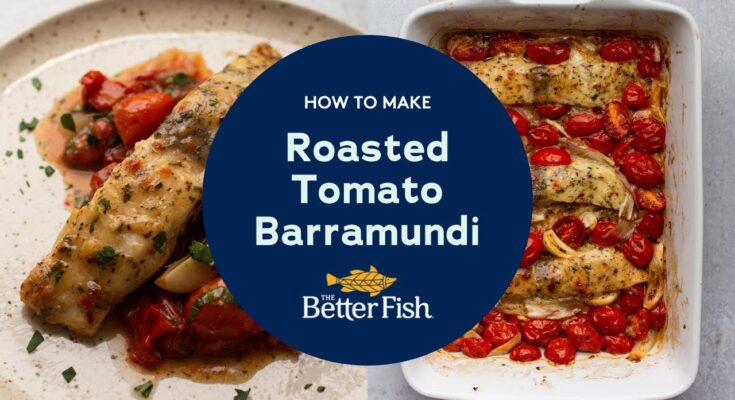Barramundi Recipe: Barramundi, often hailed as the “Asian sea bass,” is a tropical fish native to the Indo-Pacific region. It’s particularly prized for its delicate flavor, flaky texture, and nutritional benefits. Whether you’re a seasoned cook or just diving into seafood recipes, barramundi makes an excellent choice due to its versatility and ease of preparation. This lean, protein-rich fish is not only tasty but also high in Omega-3 fatty acids, making it a heart-healthy choice for meals.
The mild flavor of barramundi makes it a blank canvas for a wide range of seasonings, marinades, and cooking techniques. It holds up well in various dishes, from casual family dinners to gourmet meals. Whether you grill it, bake it, or pan-sear it, you’re bound to impress with this fish.
Why Choose Barramundi for Cooking?
There are many reasons why barramundi stands out in the kitchen. First off, it’s a sustainable seafood option. Thanks to responsible aquaculture practices, barramundi is often farmed without the use of harmful antibiotics and with minimal impact on the environment. That’s a big win for eco-conscious cooks!
Second, barramundi’s mild, buttery flavor appeals to a broad audience—including those who don’t usually enjoy fish. It’s also relatively odorless compared to more pungent fish like salmon or mackerel, which is ideal if you’re cooking in a small kitchen or want to keep the seafood scent to a minimum.
Lastly, barramundi cooks quickly and evenly, making it perfect for weeknight dinners. It doesn’t flake apart easily when handled right, so even beginner chefs can achieve restaurant-quality results.
Ingredients You’ll Need
Fresh Ingredients for Flavor
The base for a great barramundi dish lies in fresh ingredients. Here’s a list of what you’ll need for a simple yet delicious recipe:
- 2 fresh barramundi fillets (about 6 oz each)
- 2 tablespoons olive oil
- 1 tablespoon lemon juice (freshly squeezed)
- 2 garlic cloves (minced)
- 1 teaspoon sea salt
- 1/2 teaspoon black pepper
- 1 teaspoon fresh thyme or parsley (chopped)
- Lemon wedges for garnish
These ingredients bring out the natural sweetness of the fish without overpowering it. The combination of lemon and garlic adds brightness and depth, while herbs provide that extra layer of aroma and taste.
Optional Add-ons and Seasonings
Want to kick it up a notch? Here are some optional ingredients to enhance your barramundi:
- A dash of paprika or cayenne pepper for heat
- A spoonful of Dijon mustard for a tangy bite
- Capers or olives for a Mediterranean twist
- Butter for added richness
- White wine for deglazing and depth
Feel free to experiment based on your personal taste preferences. Barramundi is like a chameleon—it adapts beautifully to different flavor profiles whether Asian, Mediterranean, or classic Western.
Prepping the Barramundi
Cleaning and Filleting Tips
Before you even turn on the stove, proper preparation is key. If you’re working with whole barramundi, make sure it’s cleaned, descaled, and filleted. Here’s how:
- Descale the fish: Use the back of a knife to gently scrape off the scales, working from tail to head.
- Remove fins and guts: A good pair of kitchen shears helps here. Rinse thoroughly under cold water.
- Fillet the fish: Use a sharp fillet knife to slice along the backbone, separating the flesh from the bones in one clean sweep.
Buying pre-filleted fish from the market? Great—you’re halfway there! Just make sure it smells fresh (like the ocean, not fishy) and the flesh is firm and glossy.
Marinating for Maximum Taste
Marinating adds depth and tenderness to your barramundi. Here’s a quick marinade recipe:
- 2 tablespoons olive oil
- 1 tablespoon lemon juice
- 1 garlic clove (minced)
- A pinch of salt and pepper
- Fresh herbs (thyme or rosemary)
Mix all ingredients and coat the fish evenly. Let it sit for 15–30 minutes in the refrigerator. Don’t marinate for too long—acidic ingredients like lemon can “cook” the fish if left too long, making it mushy.
Cooking Methods for Barramundi
Pan-Frying Barramundi
Pan-frying gives your barramundi a crispy, golden crust while keeping the inside moist and flaky. Here’s how to do it:
- Heat the pan: Use a heavy-bottomed skillet and heat 1 tablespoon of olive oil over medium-high heat.
- Cook skin-side down: Place the fillet skin-side down first for about 4–5 minutes. Press lightly with a spatula to prevent curling.
- Flip and finish: Turn the fish and cook for another 2–3 minutes until the flesh is opaque and flakes easily.
This method is quick and yields restaurant-quality results with minimal fuss. It’s great for a weeknight meal and pairs well with a fresh salad or roasted veggies.
Baking Barramundi in the Oven
Baking is one of the easiest and healthiest ways to prepare barramundi. It’s virtually foolproof and locks in moisture, making it ideal for those who don’t want to fuss over the stove.
- Preheat the oven to 375°F (190°C).
- Prepare the baking tray by lining it with parchment paper or lightly greasing it with olive oil.
- Place your marinated barramundi fillets on the tray skin-side down.
- Add extras like cherry tomatoes, thin lemon slices, and chopped herbs around the fillets for flavor and color.
- Bake for 15–20 minutes, depending on the thickness of your fish. You’ll know it’s done when the flesh is opaque and flakes easily with a fork.
The great thing about baking is how hands-off it is. While the fish is in the oven, you can prep your sides or set the table. It also gives you a healthier dish with less oil but just as much flavor. Plus, it’s excellent for batch cooking!
Grilling Barramundi Outdoors
If you’re hosting a BBQ or just love the smoky flavor of grilled fish, then grilling barramundi is the way to go. It’s perfect for summer cookouts or anytime you want to add some charred goodness to your meal.
- Preheat your grill to medium-high heat.
- Oil the grill grates well to prevent sticking.
- Brush the fillets lightly with oil and season as desired.
- Grill skin-side down for 4–5 minutes, then carefully flip using a wide spatula.
- Cook the other side for 3–4 minutes until done.
Grilled barramundi goes beautifully with tropical salsas, grilled veggies, or even wrapped in a tortilla for fresh fish tacos. For an extra smoky taste, try grilling it on a cedar plank.
Serving Suggestions and Pairings
Side Dishes That Compliment
Barramundi is incredibly versatile, so you’ve got tons of options for sides. Here are some pairing ideas that elevate the meal:
- Crispy roasted potatoes with rosemary
- Garlic butter rice or lemon pilaf
- Steamed or grilled asparagus
- Simple arugula salad with vinaigrette
- Sautéed spinach or kale
The key is balance. If your barramundi is citrusy, pair it with something savory. If it’s heavily spiced, go for a cooling yogurt dip or a mild salad. Keep it colorful and nutritious!
Sauce and Garnish Ideas
The right sauce can take your barramundi to the next level. Here are some go-to options:
- Lemon butter sauce – A classic that never fails.
- Garlic herb aioli – Creamy and punchy.
- Mango salsa – Sweet and spicy for a tropical vibe.
- Caper and white wine sauce – Tangy and elegant.
Don’t forget garnishes! Fresh herbs, microgreens, toasted nuts, or even edible flowers can make your plate pop both in flavor and presentation.
FAQs About Barbecue Ribs Recipe
1. What’s the best cut of ribs for BBQ?
Pork baby back ribs are the fan favorite—tender, lean, and quick to cook. If you want something meatier and more flavorful, go for St. Louis-style ribs or spare ribs.
2. Should I boil ribs before grilling?
Boiling ribs can make them tender faster, but it also washes out a lot of flavor. Instead, try slow baking or smoking them low and slow for juicy, fall-off-the-bone goodness.
3. How long should I cook ribs on the grill?
For the perfect barbecue ribs, grill them over indirect heat for 2.5 to 3 hours. Patience = flavor!
4. What temperature should ribs be cooked to?
Ribs are safe to eat at 145°F (63°C), but for that melt-in-your-mouth texture, aim for an internal temp of 190–203°F (88–95°C).
5. Can I make BBQ ribs in the oven?
Absolutely. Season, wrap in foil, and bake at 300°F (150°C) for 2.5–3 hours. Finish them under the broiler with sauce for that caramelized crust.
6. Do I need to remove the membrane?
Yes! That silver skin on the back of the ribs can get chewy. Peel it off before seasoning for better texture and flavor absorption.
7. What’s the secret to tender ribs?
Low and slow cooking, a good dry rub, and resting time. Bonus points if you wrap them in foil to lock in moisture during cooking.
8. Should I use a dry rub or marinade?
Dry rubs give ribs a rich, crusty bark, while marinades add moisture and zing. You can do both—but don’t skip the rub.
9. When should I add BBQ sauce?
Slather it on during the last 20–30 minutes of cooking to avoid burning. Earlier, and you’ll get bitter, blackened sugar.
10. How do I store leftover ribs?
Wrap tightly in foil or place in an airtight container. Refrigerate for up to 4 days, or freeze for up to 3 months. Reheat low and slow for best results.
Conclusion
Cooking barramundi is a delight, not just because it’s tasty and healthy, but because it’s so forgiving. Whether you bake, grill, or pan-fry it, the key is not to overcook. Keep an eye on texture—when the flesh turns opaque and flakes easily, you’re good to go.
Use fresh ingredients, don’t skip the marination, and choose the right sides and sauces to complement your dish. Once you’ve nailed the basics, feel free to experiment with flavors and presentation. The more you cook with barramundi, the more creative you’ll get.
So go ahead—try this recipe tonight and treat yourself (and your guests) to a restaurant-quality meal at home. Once you master it, barramundi just might become your new favorite fish!



